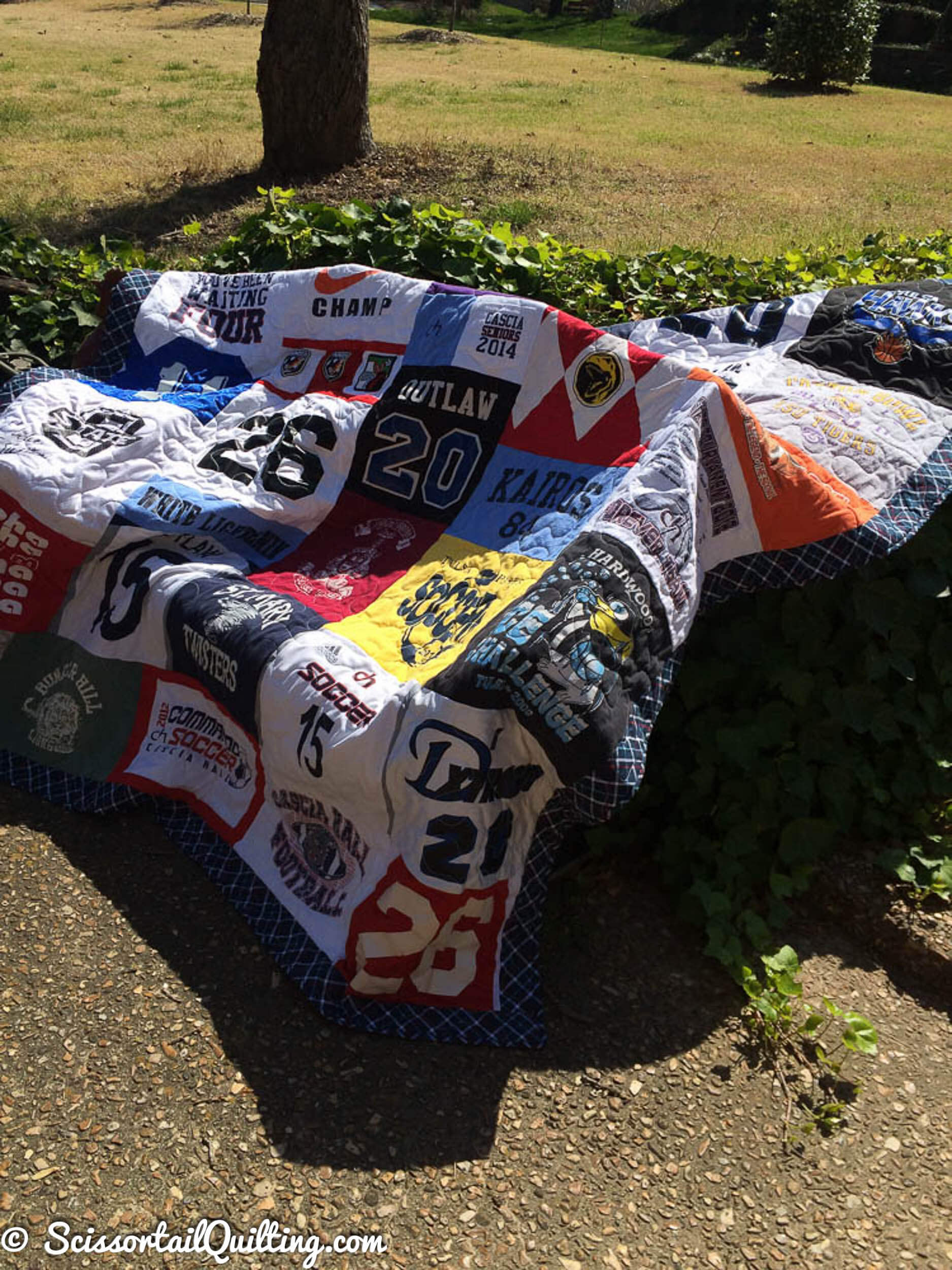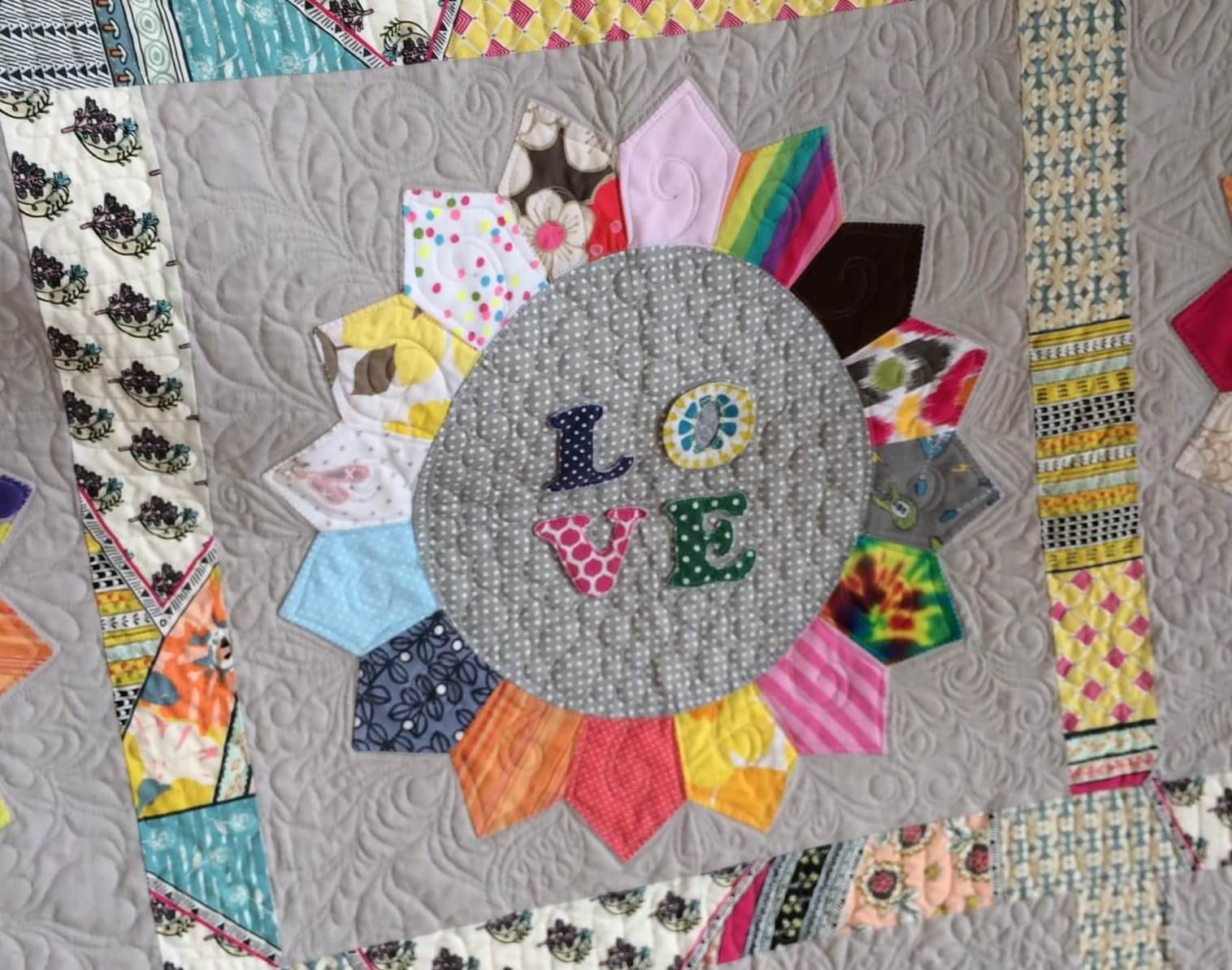Should you make your own T-Shirt quilt? A cost analysis
Estimated reading time: 8 minutes
A friend of mine recently decided to have a T-Shirt quilt made for her daughter. Recycling her daughter’s old shirts into a quilt seemed like the perfect way to preserve some beautiful memories. She began to get quotes for the project and discovered that having the quilt made would cost her much more than she had anticipated. It left her wondering, “Should I try to make it myself?” Perhaps you are like my friend and you are trying to decide if you should make your own memory quilt? In this article, I outline all of the costs involved so you can decide if it’s something you should do. We will detail some practical reasons why you might want to do it yourself, and we will consider some other factors that might swing you the other direction. I’ve also created a worksheet that you can use to help you in your own analysis, which you can download for free using the link at the bottom of this page.
I have a great appreciation for DIY-ers. (Hey!…I AM a DIY-er!) Having attempted to do many things myself, I eventually came to this conclusion: sometimes it’s worth it and sometimes it is not. The trick is to find out up front what is involved so that you can make an informed decision. My goal in this post is to help you do that.
There are many variables, so let’s make a few assumptions:
Assumption #1: You have access to a working sewing machine and a good iron. These are essential pieces of equipment. If you don’t have them you can’t make the quilt. I DO NOT recommend purchasing cheap models from a big box store to get you through the project—for most people this will only end in frustration and $200 down the drain, which could have been applied to having the quilt made.
Assumption #2: This T-Shirt quilt is going to be a “traditional” style quilt with sashing, borders, and binding.
Assumption #3: The quilt in our example is twin size, measuring approximately 60” x 88”.
Assumption #4: The items we purchase will not be over-the-top expensive, but will be good enough quality to do the job right. All of the items listed below were actually purchased at a local quilt shop by a customer getting ready to make their first T-Shirt quilt. The prices quoted are current best prices from Amazon as of today’s date.
The Breakdown:
Tools & Equipment:
| Item | Reason you need it: | Cost |
| Rotary Cutter | Used with a mat and rulers to make very precise and straight cuts. Indispensible tool. Recommend 45mm size. | 15.49 |
| 18” x 24” Rotary Mat | Self healing surface for making cuts with rotary cutter. Protects blade and your table. A larger one would be preferable, but the 18×24 should get the job done. | 26.47 |
| Scissors | You will need a good SHARP pair of fabric shears for cutting away the necklines and sleeves of the shirts. | 24.25 |
| Applique Pressing Sheet | A sheet of Teflon that allows you to press over the T-Shirt without gunking up your iron or (worse yet) melting the design on the T-Shirt. | 11.57 |
| 15” Acrylic Square Up Ruler | Used with the mat and cutter. Allows you to cut the T-Shirt into a perfect square—accuracy is critical to match up corners and seams. | 26.30 |
| 24” Acrylic Strip Ruler | Used with the mat and cutter. This ruler allows you to cut long strips of fabric. Useful in cutting straight sashing, borders and binding strips. | 16.62 |
| Pattern | Not only is this your roadmap, but it’s usually full of helpful tips and instruction. Sure, you can watch some YouTube videos, but they sometimes leave out details that a pattern will have. If you take a class, a pattern is usually required due to copyright laws. There are lots of options out there. $12.00 is an average price. | 12.00 |
| TOTAL: Tools & Equipment | $132.70 |
Materials: (based on a twin size quilt)
| Item | Reason you need it: | Cost |
| Thread | You want to make sure you use a fresh spool of good quality thread that will not break easily. Long staple 100% Cotton thread is recommended. This not only helps secure the fabrics, but it also solves a ton of sewing machine woes. | 3.70 |
| Fusible Interfacing | Because T-Shirt cotton is a stretchy knit, you need to stabilize it so that it will not become distorted as you sew. Otherwise, you will have a crooked mess. I recommend French Fuse, often sold in 90” wide bolts at $7.99 yard. (2.5 yards are required.) | 19.98 |
| Fabric for sashing, posts, borders, and binding | It is possible to find fabric at $6 a yard at certain big box stores, but often the quality is questionable and you will have shrinkage issues. If I’m going to spend hours on a quilt, I want it to last a hundred years. It’s worth it to me to buy quality fabrics. They usually run $12-13 a yard. This quilt requires 4 yards @ $12 per yard. | $48.00 |
| Batting | Goes inside the quilt for added fluffiness and warmth | 13.99 |
| Fabric for backing | The biggest single expense of any quilt due to large amount of fabric required. 5.25 yards @ $12 per yard | 63.00 |
| Total cost of materials: | $148.87 |
Other Expenses:
| Item | Reason you need it: | Cost |
| Class Fee | Most novice quilters benefit from taking a project class at a local quilt shop. Not only do they receive great instruction, but someone is holding their hand through the tricky spots. It’s great incentive to finish the project. | $60 |
| Long-arm Quilting | Just sewing the T-Shirts together does not make a quilt. What makes a quilt is having the three layers of top, batting and backing “quilted” or stitched together. This is a whole other animal. It can be stitched together with straight lines or with elaborate swirls, feathers or floral designs. Many people who quilt as a hobby do not actually quilt their own tops, but prefer to send them out to a Long-armer to do the quilting portion of the job. The reason? It takes a special skill, a special set up and lots of room. Prices vary depending on the density of the quilting and size of the quilt, but the cost is usually 2 cents per square inch. Our quilt measures 5580 square inches. | $105.00 |
| Your time | Novice quilters can expect to spend 25-30 hours cutting and sewing the top of this small quilt. Set an hourly wage for yourself to determine how much your time is worth. Since I can’t calculate this for you, it will not be reflected in our total. | ?? |
| Total: Other Expenses | $165.00 + |
Grand Total to make it yourself: $446.57+
Keep in mind that this total does not include a sewing machine, sales tax, or the value you place on your 25-30 hours of labor. Factor those things back in, and compare your new total with the quotes you get. Now ask yourself: Are you saving a significant amount of money doing it yourself?
Are there more ways you can save money? Sure. If you choose to quilt it yourself, you can save $105, but you need to add 10 or more hours back to your labor time. Another way to save money is to shop fabric sales to find quality fabric at cheaper prices. If you have a friend who quilts, perhaps they will let you borrow their tools so you can save money on equipment.
So, is it worth it to you? Let’s think this through.
If money is really tight in your household, and you have access to a well functioning sewing machine, you should ask yourself these questions:
- Do I have the time to complete the project? Nothing is worse to a household on a tight budget than to sink money into a project that doesn’t get finished. Also, think back to that number you placed on your time. Nothing is more valuable than your time, so after considering all the costs, decide if it would be more beneficial for you to have that time for other things.
- Do I have the skills (or can I acquire the skills) to finish the project? Do you think there is a good chance you will be happy with your workmanship? If you’re a perfectionist, then you might want to consider hiring a professional quilter.
- Do the savings in labor justify the expense in tools and equipment? Again, if you’re on a tight budget, you might see the equipment and tool expense as wasteful for a one time project. But if you think you might like to learn how to make more quilts in the future, then it’s an investment. BTW, a T-Shirt quilt is a great first quilting project. You just might get hooked!
- Is it important that the quilt be made by you? I understand. I once told one of my sons that I was so swamped that I was sending his quilt off to be finished by someone else. He was horrified. (Who would have thought that he cared???) Ever since, I’ve quilted them myself. If you’re going for the “I made this because I love you” factor, we both know that you really don’t care what it costs you in money or time.
So, there you have an honest look at what costs are involved in making a quilt. I hope this has helped you make up your mind. If you want to explore your costs further, download my worksheet by clicking here.
If you think you want to make your own T-Shirt quilt, I have two patterns in my shop that can guide you through the project.
If you want to talk to me about making a custom quilt for you, please contact me.






